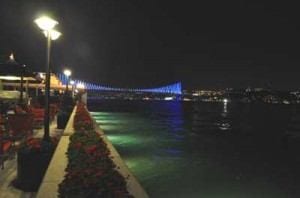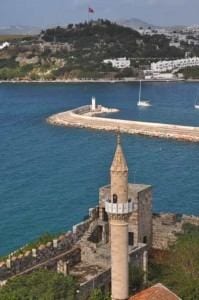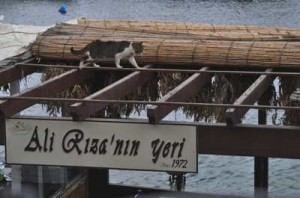 Labor Day has come and gone and we’re heading into the final months of 2012. Instead of focusing on fall foliage or the Christmas holidays, Peter wants you to maximize your 2012 travel. This September our contributors are covering some bucket list dream destinations. And tomorrow, Peter is hosting his a Twitter party (starting at 3:30pm ET/ 12:30pm PT) all about the better bucket list. Follow along with #betterbucketlist, to share your travel stories, get Peter’s advice and potentially win one of five travel Australia gift baskets.
Labor Day has come and gone and we’re heading into the final months of 2012. Instead of focusing on fall foliage or the Christmas holidays, Peter wants you to maximize your 2012 travel. This September our contributors are covering some bucket list dream destinations. And tomorrow, Peter is hosting his a Twitter party (starting at 3:30pm ET/ 12:30pm PT) all about the better bucket list. Follow along with #betterbucketlist, to share your travel stories, get Peter’s advice and potentially win one of five travel Australia gift baskets.
Up first in our fall bucket list adventures is Turkey, where Virtuous Traveler Leslie Garrett takes apart all the preconceptions that comes with a first-time trip to Turkey and shows how to understand the culture that embraces travelers while often defying modernity.
I’m seated at a long banquet table in Istanbul enjoying yet another fabulous meal of the usual Turkish delights – eggplant, artichokes, black olives, tomatoes, lamb. Across the table, a fellow traveler begged off the lamb, citing a “lambover” from three days of binging on it, and asked for beef instead. My lamb is, again, delicious.
To my left, a young, gorgeous Turkish woman is telling us the bad fortune she’s experienced of late. Unsuitable suitors, apartment woes, the customary laments of 20-somethings the world over. All, she explains, because she hasn’t yet replaced her evil eye after it mysteriously fell from her wall and smashed on the ground.
Seriously?
Yes. Seriously. It’s another reminder that I’m in Turkey, a country that bewilders as much as it bewitches.
When the opportunity to go to Turkey came up…I asked myself, “What did I really know about Turkey?”
I had been reading in the news about Kofi Annan using it as headquarters as he tried – unsuccessfully – to broker a peace treaty within Syria. I then pulled out a map, noting that Turkey nestled up, at least geographically, against Iraq and Iran, with Syria to the south. Would I need a bulletproof vest? Speaking of clothes, Turkey is Muslim, I thought. Suddenly the clothes hanging in my closet seemed…well…slutty.
For decades, Turkey was the bridesmaid, never the bride, as tourists flocked to better marketed destinations for beaches and culture. As recently as 1998, fewer than 10,000,000 travelers annually made the trek, a number that has more than tripled in the decade and a half since.
 Turkey’s Saint Tropez
Turkey’s Saint Tropez
One caution, Istanbul’s international airport is chaos. I tried to pay for my Turkish Visa with Canadian money, which was rejected, along with my credit cards (fortunately I had some US dollars tucked away), and English-speaking help was impossible to find. Thanks to Turkish Airlines’ thrice weekly (off-season) domestic flights from Istanbul, I head straight to Bodrum.
Built on the ruins of ancient Halicarnassus where the Aegean and Mediterranean seas converge, Bodrum was a quiet fishing village until the 1970s. With the increase in tourist traffic, it has exploded with hotels, nightclubs, upscale shops and tour boats.In fact, Bodrum is now known as Turkey’s San Tropez. As you might expect, there is plenty of glamor – yachts with sky-high masts, chic shoppers and boutique hotels.
Despite the glitz I discovered that it is still possible to find a small restaurant along the water, where lunch had been caught just hours earlier and the owner and his son bicker side by side, serving up salted fish, as they have for years. At the end of the table, a Turkish-American offers coffee-cup readings, a talent passed down from her mother, who lives nearby.
This is not the only spot that has defied modernity. Determined travelers might still find villages tucked away just inland that bring to mind what Homer called “the land of endless blue.”
This was the seat of the world – the home of the Byzantine and Ottoman empires, the architects of ancient civilization. By the side of a busy road, you can stop to climb over the remains of the Theatre of Halicarnassus, the oldest in the region at one time seating 13,000 people. Recent restorations have made it once again functional and it’s a popular place for outdoor concerts, the “endless blue” stretching out behind it.
Just off Pier Square (pretty but nothing you haven’t seen in many other seaside towns) is Bodrum castle, built in 1402. It’s worth risking claustrophobia on the cramped staircase for the sublime view at the top. And within the castle is the Museum of Underwater Archaeology, which houses an astonishing history of archives all excavated from underwater!
 Exploring Istanbul & Turkey’s Culture of Sharing
Exploring Istanbul & Turkey’s Culture of Sharing
One evening, over an incredible meal of – you guessed it – lamb, another Turkish dinner companion laments what he deems the almost universal misunderstanding of his country. I think back to my own trepidations about Turkey before I’d set foot in it and confess my ignorance. My dinner companion laughs, then sighs. “We’re a Muslim democracy,” he said, “a culture and religion of sharing.”
I discover this culture of sharing the very next morning, when I visit the AyaSofya Hammam – a luxurious white marble marvel – in Istanbul the following day. I’d heard, of course, of the legendary Turkish baths and assumed them to be hedonistic. A sort of orgy with loofah. The woman assigned my ablutions, however, was no-nonsense, a Turkish Mary Poppins, who smiled toothlessly and indulgently as she tenderly stripped me – alongside a dozen other naked women – of not only my epidermis but my self-consciousness. I was exposed in more sense than one…and it felt wonderful.
I emerge into blinding sunlight, restored and more polished than I’ve been before or since, and step back onto the busy streets of Istanbul and into its rich past.
Around the corner from the hammam is the rest of the Turkish trifecta: the Blue Mosque, the Hagya Sofia… impossible to describe without hyperbole. A cruise along the Bosphorus, the strait that famously divides Europe and Asia, offers up plenty more: Topkapi Palace, the Rummeli Citadel, the bridge itself at night, lit since 2007 with thousands of computerized LED lights.
 Having Tea at The Grand Bazaar
Having Tea at The Grand Bazaar
I’m clearly a target for merchants and grow weary of “you like?” each time I attempt to navigate the narrow streets of the Sultanahmet area around my hotel. Nonetheless Istanbul’s Grand Bazaar beckons – all 61 covered streets and more than 3,000 stalls – though I’ve been warned by a friend that anything on offer at the bazaar could be had in the streets of Istanbul for cheaper.
I want a Turkish scarf. Perhaps two. I inquire casually about price trying to conceal my desire. Silk! Fine cotton! And the colors! I quickly learn that no negotiation is complete without the requisite tea. Price agreed upon, we sit down and sip. It’s a ritual that changes a transaction into a relationship and is far more civilized than the soulless and anonymous malls of America. Maybe I pay more for my Turkish scarves than I might have elsewhere but darn if the experience isn’t worth it.
What’s more, I make sure to stop by a booth that sells nothing but Evil Eye merchandise: wall hangings, bracelets, necklaces, plates, key chains… I stock up, telling myself that I love the blue, white and yellow. That they make fun souvenirs. That they’re a lark.
On my flight home, I’m still trying to make sense of all I’ve seen and done. I wasn’t killed by the Syrian army, though they’d begun firing across the Turkish border refugee camps. (Syria is far away, said anyone I asked, dismissing my concerns with a wave of their hands.) I saw fewer women with heads covered than I see in Toronto. I had worn my head scarf exactly once.
And then I notice, above the names on the uniforms of my Turkish Airlines flight crew, tiny evil eyes. I think back to my dinner conversation and smile. Turkey has a deep history marked by conquering and being conquered, yet it remains surprisingly apart from the surrounding unrest.
Geographically, it spans Europe and Asia, yet seems neither European nor Asian. It is, in the midst of fundamentalist Middle East, a Muslim democracy and has been so since the 1920s, a time when veiling of women was discouraged and the fez abolished.
It is at once secular, with deep roots in the sacred. And it’s a country where a young woman – single, educated, ambitious – can believe absolutely in the power of a talisman to dictate her fate. And, as I recall the Evil Eye I purchased to hang in my own home, to make a believer out of me.
For more information on travel to Turkey , check out:
- Off The Brochure: Istanbul, Turkey
- Our 2011 report, Turkey Post Earthquake: Is Travel Safe? Will Tourism Be Disrupted?
- The Middle East travel archives
Text and photos by Leslie Garrett for PeterGreenberg.com. Leslie Garrett is an award-winning journalist and author of The Virtuous Consumer: Your Essential Shopping Guide for a Better, Kinder, Healthier World. Visit her at www.virtuousconsumer.com.












